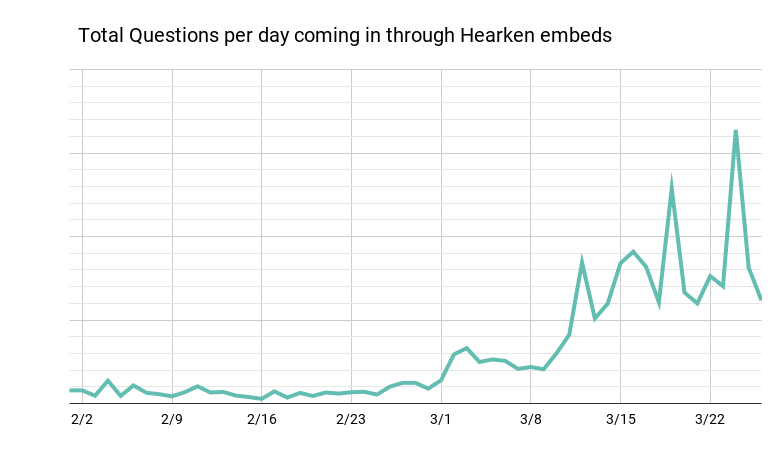The world is changing and, with it, our role as journalists.
While it’s not clear when the rush of breaking news will subside, it will. Still, nothing will return to the ‘normal’ we knew — and journalism’s pre-coronavirus state already wasn’t financially strong.
A better, more sustainable path might be easier than you might think. One key is to foster deeper relationships with your audiences as partners rather than customers/audience members. Another is to write about how communities are rebuilding and reviving just as well as you cover breakdowns, problems and collapse.
Many smart newsrooms already have been using these approaches for years, finding so much success they say there’s no going back to the old way.
The reasons are two-fold:
- Audience support: All those new people who’ve turned to us about what was going wrong and why? We need to keep them onboard for our financial survival, and we already know many will fade away if we continue to swamp them with a diet of problem-heavy news.
- Our mission: We got into this business to help people in our communities thrive as individuals and as a group. That means making sure we understand what information they need and help them get it.
Meeting the tsunami of need
In March, rolling shutdowns across the U.S. left many uncertain about what was about to happen and what they should do. Hearken’s engagement platforms received an unprecedented level of submissions from audiences turning to their news sources for crucial information.

This wasn’t just a wave — it was a sustained tsunami. KPCC, a public radio station in Southern California, was at one time receiving almost 10 questions a minute through Hearken.
And it was just the latest example of a pattern we’ve seen proven time and time again.
[Read more: Journalists in Europe complicate the narrative of colonization]
Engagement is highest in times of need
Newsrooms have been continually pressed to feed this need with accurate information. The fact is, with very few exceptions, we’re all new to the coronavirus beat. We’re living through a deeply disruptive global crisis on a scale that hasn’t been seen in generations. At the same time, we’re examining the deep racial biases that exist inside and outside our newsrooms. So how do you even begin to identify what should be covered, and where to put your precious reporting resources? The answer comes down to our most basic reporting instincts: ask people what they need to know (aka do not assume you know).
In the face of uncertainty, ask
Ask often, and ask everywhere. Ask your current audience and ask people you don’t regularly reach. Ask over and over again and never stop asking.
- The Baltimore Sun posts an easy-to-use URL to its central hub for asking questions at the end of their Facebook videos responding to reader questions.
- Sahan Journal created articles in four different languages answering and inviting coronavirus questions.
Engagement is not a product, it is a process. You reach out over and over again to inform your reporting. And you are never finished, because the news is never finished.
This is how we identify what news needs to be covered, when, and how. This is how we find new voices to include in our coverage. This is how we keep an eye on what matters now and what will matter in the coming weeks. And this is what pretty much every other industry does to ensure that what they’re making is relevant and useful to the people they’re making it for!
At this time, newsrooms need to be ready to:
- Uncover the most pressing informational needs of their communities
- Reach out to the groups that you haven’t been using as regular sources
- Design impactful coverage in response to their informational needs
[Read more: Impact-driven journalism during the pandemic]
Light candles rather than curse the darkness
Newsrooms should continue to root out problems — that’s vital. It’s equally as important to write about how people are responding to those problems in resilient, novel and effective ways. Sure, your audience wants to know about what’s wrong, but they also want to understand what might be done about it, who’s making progress, what lessons we can draw from those who’ve tackled even a small piece of a big problem. This is solutions journalism — the practice of sifting through the noise to find potential seeds of how to move forward.
In other words, your audiences’ informational needs don’t stop at identifying problems.
Here’s a couple more truths we’ve seen again and again:
People want to face big problems, but with hope. The people who are experiencing a problem already know what’s wrong. They want to know what can be done about it. That doesn’t mean journalists will or should decide what solutions should be. We can ask ‘Who’s doing it better,’ and report on models our communities should consider as they work to move forward.
Solutions journalism can have big impact. Traditional investigative reporting typically uncovers new problems. Solutions investigative stories tackle well-known problems and ask: Does it have to be this way? What might be possible? What are other cities/states/neighborhoods doing? What results did they get? It enables people to work toward fixing problems that institutions haven’t.
- Just last year, for example, the city of Cleveland finally passed a landmark law to help prevent childhood lead poisoning, after the Cleveland Plain Dealer spent years illuminating not just what was going wrong, but how other cities successfully kept their poisoning rates much lower.
- At The Seattle Times, the innovative Education Lab project has helped change state and local policies when it comes to school discipline and gifted education.
Solutions journalism also is a process, not a project. You don’t stop at reporting on one promising practice, but continue to look for others — and then circle back to see what worked and what didn’t. If an effort continues to work, great. If it’s falling short, people need to know that, too.
At this time, newsrooms must:
- Determine which voices need to be heard and elevate them. That means making sure you’re talking to the people affected by a problem and not let others define the challenges they face.
- Examine proposed responses with a solutions lens, looking for evidence they could make a difference.
- Uncover the key insights that will drive progress while also acknowledging limitations.
Making this happen in your newsroom
How exactly are those news organizations creating coverage that uncovers what the public most needs to know, and identifies possible ways to solve the challenges they face?
We’ve created a 16-step checklist outlining the steps our partners are taking toward their engagement and solutions reporting. Anyone, at any level of authority in the newsroom, can use this checklist to create relevant coverage that drives impact.
We’ve made it an easy-to-use, two-page downloadable file for you to use as you build your coverage strategy.
Download your checklist here
2020 has been a torrent of news, and it can feel like you’re drowning in angles to cover. Consider this a life raft, one built with the help of your community, to stay afloat and chart your course forward.
Linda Shaw is the editorial director at the Solutions Journalism Network. Bridget Thoreson works industry insights and engagement strategies with Hearken.
This article was originally published by the Solutions Journalism Network on their blog. It was republished on IJNet with permission.
Main image CC-licensed by Unsplash via Kelly Sikkema.

